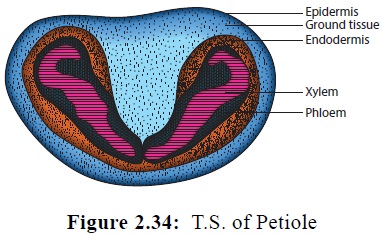Chapter: 11th Botany : Chapter 2 : Plant Kingdom
Adiantum - Pteridophytes

Adiantum
Division – Pteropsida
Class - Leptosporangiopsida
Order – Filicales
Family – Polypodiaceae
Genus – Adiantum
Adiantum is commonly known as ‘Maiden hair fern’ or
‘Walking fern’. They are distributed in the tropical and temperate regions of
the world. Some of the Indian species include Adiantum capillus-veneris, Adiantum
pedatum, Adiantum caudatum and Adiantum
venustum. The sporophyte is differentiated into rhizome, roots and leaves
Figure 2.31.

External features
Rhizome
The rhizome is a perennial, subterranean
dichotomously branched structure and is creeping in A. capillus-veneris or may be erect as in A. caudatum. It is covered with persistent leaf bases and hairy
outgrowths called ramenta.
Root
The roots are adventitious and arise from the
rhizome.
Leaf
The leaves are also called fronds and are pinnately compound (unipinnate- A. caudatum, bipinnate- A. capillus- veneris) the young leaves are circinately coiled. The petiole is long, black and shiny. The venation is free and dichotomous in all the species. The vein spread in a fan-like manner in the lamina. The leaves bear marginal sori which are covered by a false indusium.
Internal structure
Root
The root is differentiated into epidermis, cortex and central vascular cylinder.
The epidermis is the outermost layer and bears
unicellular root hairs. The cortex is divided into outer wide parenchymatous
and inner narrow sclerenchymatous layer. The stele is simple and possesses a
central core of xylem in diarch condition with phloem on either side of it
(Figure 2.32).

Rhizome
The rhizome in transverse section shows a single
layered epidermis covered by cuticle. Some epidermal cells bear multicellular
hairs. The Epidermis is followed by two to three layered hypodermis made up of
sclerenchyma tissue. A parenchymatous ground tissue is present. The young
rhizomes have amphiphloic siphonostele. The older rhizomes have solenostele or dictyostele
(Figure 2.33).

Petiole
The petiole in T.S. shows a single layered
epidermis with thick cuticle. Epidermis is followed by a sclerenchymatous
hypodermis which provides mechanical support. There is an extensive parenchymatous
ground tissue. The central region possesses a single large horse shoe shaped
stele. Xylem forms central core surrounded by phloem (Figure 2.34).

Pinnule
The Pinnule shows upper and lower epidermis. The
cells contain chloroplasts. Stomata are confined to lower epidermis. The
mesophyll is not differentiated into palisade and spongy parenchyma. The
vascular bundle is surrounded by sclerenchymatous bundle sheath.
Reproduction
Adiantum is
homosporous. The reproduction takes place
by the production of spores. The spores are produced in sporangia. A group of
sporangia forms sori. The sori are marginal but the reflex margins of the pinna
form a protective membranous structure called false indusium (Figure
2.35). The development of sporangium
is of leptosporangiate type.

The sorus does not show any definite sequence hence
fall under mixed type.
A mature sporangium bears a multicellular stalk and
a spherical or elliptical single layered structure called capsule. The capsule contains haploid spores. The wall of the
capsule is differentiated into thick walled annulus and thin walled stomium. On maturity the sporangium
bursts and spores are released. The spores germinate and undergo repeated
division to produce a prothallus.
The prothallus is flat, green and heart shaped. It is monoecious and represents
the gametophytic phase. Sex organs called antheridia
and archegonia develop on the
prothallus. Antheridia release multiflagellate antherozoids which swim in water
and reach the egg of the

The fertilization results in zygote(2n) and it represents the first cell of sporophytic generation. The zygote develops into embryo which further differentiates into sporophyte. Thus Adiantum shows alternation of generation (Figure 2.36).
![]()
![]()
![]()
Related Topics